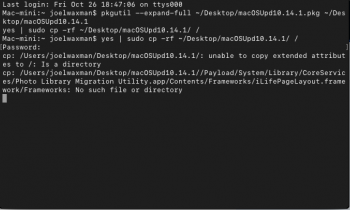My definition of "clean install" is the very same.
So... even though we had 10.13 and native firmware support for APFS, the installer for 10.14 must still initially be pointed to a HFS+ formatted drive? Is that a statement or a guess? (The "That doesn't sound right..." part is hopefully apparent.
I didn't try that yet (clean install to HFS+). Maybe I will and give it one last chance.
I've got to say though. Running in 10.14 and poking around a bit (issues already mentioned aside)...
This OS makes the computer crawl! This is VERY noticeably slow and laggy. Like "Dell running Windows" slow! Not even exaggerating. Not just extra long boot times but genuine slow laggy response.
To the trash heap with this OS!
I think 10.13.6 might the end of the line for OSX folks. Someone grab the fork...
So... even though we had 10.13 and native firmware support for APFS, the installer for 10.14 must still initially be pointed to a HFS+ formatted drive? Is that a statement or a guess? (The "That doesn't sound right..." part is hopefully apparent.
I didn't try that yet (clean install to HFS+). Maybe I will and give it one last chance.
I've got to say though. Running in 10.14 and poking around a bit (issues already mentioned aside)...
This OS makes the computer crawl! This is VERY noticeably slow and laggy. Like "Dell running Windows" slow! Not even exaggerating. Not just extra long boot times but genuine slow laggy response.
To the trash heap with this OS!
I think 10.13.6 might the end of the line for OSX folks. Someone grab the fork...







